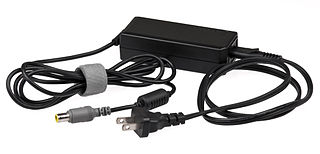
An integrated circuit (IC), also known as a microchip, computer chip, or simply chip, is a small electronic device made up of multiple interconnected electronic components such as transistors, resistors, and capacitors. These components are etched onto a small piece of semiconductor material, usually silicon. Integrated circuits are used in a wide range of electronic devices, including computers, smartphones, and televisions, to perform various functions such as processing and storing information. They have greatly impacted the field of electronics by enabling device miniaturization and enhanced functionality.

A backlight is a form of illumination used in liquid-crystal displays (LCDs) that provides illumination from the back or side of a display panel. LCDs do not produce light by themselves, so they need illumination to produce a visible image. Backlights are often used in smartphones, computer monitors, and LCD televisions. They are used in small displays to increase readability in low light conditions such as in wristwatches. Typical sources of light for backlights include light-emitting diodes (LEDs) and cold cathode fluorescent lamps (CCFLs).

MIFARE is a series of integrated circuit (IC) chips used in contactless smart cards and proximity cards.

Nordic Semiconductor ASA was founded in 1983 and is a Norwegian fabless technology company with its headquarters in Trondheim, Norway. The company specializes in designing ultra-low-power wireless communication semiconductors and supporting software for engineers developing and manufacturing Internet of Things (IoT) products.
Signetics Corporation was an American electronics manufacturer specifically established to make integrated circuits. Founded in 1961, they went on to develop a number of early microprocessors and support chips, as well as the widely used 555 timer chip. The company was bought by Philips in 1975 and incorporated in Philips Semiconductors.

An AC adapter or AC/DC adapter is a type of external power supply, often enclosed in a case similar to an AC plug. AC adapters deliver electric power to devices that lack internal components to draw voltage and power from mains power themselves. The internal circuitry of an external power supply is often very similar to the design that would be used for a built-in or internal supply.
VLSI Technology, Inc., was an American company that designed and manufactured custom and semi-custom integrated circuits (ICs). The company was based in Silicon Valley, with headquarters at 1109 McKay Drive in San Jose. Along with LSI Logic, VLSI Technology defined the leading edge of the application-specific integrated circuit (ASIC) business, which accelerated the push of powerful embedded systems into affordable products.

The flyback converter is used in both AC/DC, and DC/DC conversion with galvanic isolation between the input and any outputs. The flyback converter is a buck-boost converter with the inductor split to form a transformer, so that the voltage ratios are multiplied with an additional advantage of isolation.
Standby power, also called vampire power, vampire draw, phantom load, ghost load or leaking electricity refers to the way electric power is consumed by electronic and electrical appliances while they are switched off or in standby mode. This only occurs because some devices claimed to be "switched off" on the electronic interface, but are in a different state. Switching off at the plug, or disconnecting from the power point, can solve the problem of standby power completely. In fact, switching off at the power point is effective enough, there is no need to disconnect all devices from the power point. Some such devices offer remote controls and digital clock features to the user, while other devices, such as power adapters for disconnected electronic devices, consume power without offering any features. All of the above examples, such as the remote control, digital clock functions and—in the case of adapters, no-load power—are switched off just by switching off at the power point. However, for some devices with built-in internal battery, such as a phone, the standby functions can be stopped by removing the battery instead.

NXP Semiconductors N.V. (NXP) is a Dutch semiconductor designer and manufacturer with headquarters in Eindhoven, Netherlands. The company employs approximately 31,000 people in more than 30 countries. NXP reported revenue of $11.06 billion in 2021.

A power supply unit (PSU) converts mains AC to low-voltage regulated DC power for the internal components of a computer. Modern personal computers universally use switched-mode power supplies. Some power supplies have a manual switch for selecting input voltage, while others automatically adapt to the main voltage.
Cambridge Semiconductor Limited (CamSemi) is a fabless semiconductor business based in Cambridge, England that was acquired by US-based competitor Power Integrations Inc., in January 2015.

DisplayLink is a semiconductor and software technology company owned by Synaptics. The company specializes in developing DisplayLink USB graphics technology, which facilitates connections between computers and displays via USB, Ethernet, and WiFi. Additionally, it supports the connection of multiple displays to a single computer.

Power management integrated circuits are integrated circuits for power management. Although PMIC refers to a wide range of chips, most include several DC/DC converters or their control part. A PMIC is often included in battery-operated devices and embedded devices to decrease the amount of space required.
Nuvoton Technology Corporation is a Taiwanese semiconductor company established in 2008. It originated as a wholly owned subsidiary of Winbond Electronics Corp. before becoming an independent entity.
Himax Technologies, Inc. is a fabless semiconductor manufacturer headquartered in Tainan City, Taiwan founded on 12 June 2001. The company is publicly traded and listed on the Nasdaq Stock Market under the symbol HIMX. Himax Technologies Limited functions as a holding under the Cayman Islands Companies Law.

Integrated Device Technology, Inc. (IDT), was an American semiconductor company headquartered in San Jose, California. The company designed, manufactured, and marketed low-power, high-performance mixed-signal semiconductor products for the advanced communications, computing, and consumer industries. The company marketed its products primarily to original equipment manufacturers (OEMs). Founded in 1980, the company began as a provider of complementary metal-oxide semiconductors (CMOS) for the communications business segment and computing business segments. The company focused on three major areas: communications infrastructure, high-performance computing, and advanced power management. Between 2018 and 2019, IDT was acquired by Renesas Electronics.

LPC is a family of 32-bit microcontroller integrated circuits by NXP Semiconductors. The LPC chips are grouped into related series that are based around the same 32-bit ARM processor core, such as the Cortex-M4F, Cortex-M3, Cortex-M0+, or Cortex-M0. Internally, each microcontroller consists of the processor core, static RAM memory, flash memory, debugging interface, and various peripherals. The earliest LPC series were based on the Intel 8-bit 80C51 core. As of February 2011, NXP had shipped over one billion ARM processor-based chips.

Helix Semiconductors, formerly Semitrex, is an Irvine, California-based fabless semiconductor company that designs chips for improved power management. The company's patented capacitive voltage reduction technology uses cascading capacitors to store power and convert voltages on chips, reducing the energy consumption of electronic devices.










